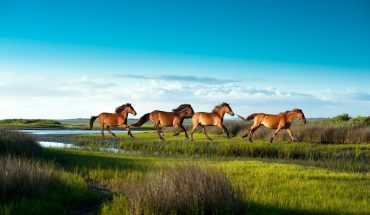by Suzanne M. Wood
As my paddle parted the clouds reflected on the water’s surface, I marveled – not for the first time that sunny fall afternoon – at how still it was. My husband and I were paddling our tandem canoe across Beaverdam Lake, a less-known next-door neighbor of Falls Lake that doesn’t allow the gas-powered boats that crowd Falls on glorious days. It wasn’t just the absence of wakes that contributed to the placid conditions: Thanks to a late-summer drought, the lake was about three feet lower than it should have been. The day was also warm, windless, and quiet, aside from the squawks of great egrets and great blue herons, and my own startled cry when a giant carp broke through the surface just two feet from the bow.
Nothing disturbed the serenity we were enjoying until I announced, “I’m thirsty,” and abruptly swiveled in my seat to reach the cooler wedged behind me, lost my balance, and tipped the canoe precariously, nearly jettisoning my paddle. After 25 years of marriage, Scott is used to my klutziness, but he looked surprised. “Please don’t flip the boat,” he muttered. Together we had braved far harsher conditions on numerous, far-flung canoe trips without so much as a granola bar overboard, so to swamp on a practically suburban lake on a picture-perfect day would be undignified, to say the least.
Once again I was grateful for our 30-year-old Mad River touring canoe. At 17 feet and 65 pounds, it’s reasonably stable, efficient, fast, and seaworthy. It’s kept us high and dry on everything from ponds to whitewater rivers to thunderstorm-whipped lakes and choppy coastal waterways.
When we were first married, Scott and I would think nothing of heading out to a lake, pond, or river for a day or just a couple of hours. Beaverdam was one of our favorites, even after a poisonous caterpillar dropped from a branch in a marshy cove and attacked Scott’s arm, leaving him writhing in pain. Then work pressures, the arrival of kids, and competing interests conspired to make those outings farther and fewer between. This trip marked the first time we had been to Beaverdam in more than 15 years.
We were not disappointed. Although it’s adjacent to Falls Lake – separated from those 12,000 watery acres by a single spillway – Beaverdam seems a world away. Its restrictions on gas-powered watercraft discourage those who pursue speed and exhilaration over exploration and wildlife viewing. Its shallow marsh on one end is choked with water lilies, duckweed, and other aquatic flora, making it a paradise for waterfowl and the binocular set.
And this is the perfect time of year to enjoy it all, when the bugs are gone, the weather is mild, and the fellow visitors few.
Years ago, we could cross the lake and then plow through the marshy plants into a chain of beaver ponds that dot the creek that feeds the lake; on this visit, due to low water, our journey ended at the marsh. With the two of us paddling from the Old Weaver Road put-in to the marsh, it took us about an hour at a leisurely pace. We saw exactly five people on the water: two sets of kayaking couples and one wetsuit-clad woman maneuvering a stand-up paddleboard about 40 feet from the shore just south of the Old Weaver Road bridge.
We also skirted around a couple of goose hunters who had constructed a blind where Beaverdam creek feeds into the lake. We weren’t surprised to see these guys, although I hadn’t realized goose season started so early in the fall. While Beaverdam south of Old Weaver Road in Wake County is part of the Falls Lake State Recreation Area, the area north of Old Weaver Road comprises game-lands managed by the N.C. Wildlife Resources Commission. Paddlers and hunters can co-exist as long as everyone knows – and plays by – the rules. While hunted species such as geese and ducks are plentiful, so are many other species of birds, especially the egrets and herons we spotted in the shallowest areas of the lake.
Indeed, birdwatchers have just as much to enjoy here as paddlers do. At one point, what looked like a bald eagle swept overhead. It turned out to be a Northern Harrier, otherwise known as the marsh hawk. And if we had remembered to bring our binoculars, we might have also been able to glimpse some of the many songbirds who called from the trees ringing the marsh.
While the lake was much as we remembered it, the recreation area surrounding it has been significantly developed since our last visit. The park boasts dozens of picnic areas with grills and shelters, two fishing piers, a couple of easy hiking trails, campsites, and a beach adjacent to the boat launch. It also features one of the few single-track mountain bike trail networks in the state parks system, 15 miles long. We were too pressed for time on our recent visit to explore the recreation area, but we vow to return in the spring with our trusty canoe, along with hiking boots, fishing rods, camping gear and, if they deign to join us, maybe even our three teenagers, too.
IF YOU GO
Beaverdam Lake and the surrounding recreation area are considered part of the Falls Lake State Recreation Area. The entrance to the Beaverdam recreation area is located at 14600 Creedmoor Road, about three miles north of N.C. 98 and about 40 miles northwest of downtown Raleigh. The state charges an admission fee; it was $6 per car when we went this fall. The put-in we favored years ago, just off Old Weaver Road near the Wake County-Granville County line, is still “unimproved,” meaning there’s no ramp or dock and you have to carry or drag your boat from the gravel parking area to water’s edge. It can be found on the south side of Old Weaver Road, on the east side of the bridge. For paddlers or jon boat owners who prefer a more civilized access point, the official Beaverdam boat ramp is located within the Beaverdam recreation area.
For more information and a downloadable map, visit ncparks.gov/falls-lake-state-recreation-area. For hunting information and regulations, visit ncwildlife.org/Hunting.aspx.





